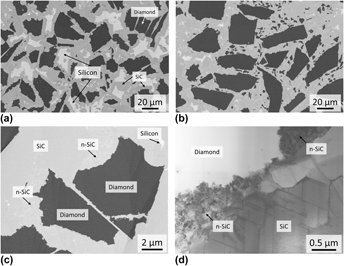Crossref Citations
This article has been cited by the following publications. This list is generated based on data provided by
Crossref.
Herrmann, Mathias
Adloff, Lena
Matthey, Bjoern
and
Gestrich, Tim
2020.
Oxidation behaviour of silicon carbide bonded diamond materials.
Open Ceramics,
Vol. 2,
Issue. ,
p.
100017.
Ast, J.
Matthey, B.
Herre, P.
Höhn, S.
Herrmann, M.
and
Christiansen, S.H.
2021.
Micro-cantilever testing of diamond - silicon carbide interfaces in silicon carbide bonded diamond materials produced by reactive silicon infiltration.
Open Ceramics,
Vol. 8,
Issue. ,
p.
100176.
Shevchenko, V. Ya.
Perevislov, S. N.
and
Ugolkov, V. L.
2021.
Physicochemical Interaction Processes in the Carbon (Diamond)–Silicon System.
Glass Physics and Chemistry,
Vol. 47,
Issue. 3,
p.
197.
Zhang, Yuying
Wang, Tianshi
Hsu, Chun-Yen
Wynn, Justin
Karandikar, Prashant
Feser, Joseph P.
and
Ni, Chaoying
2021.
Thermal transport characteristics in diamond/SiC composites via molten Si infiltration.
Ceramics International,
Vol. 47,
Issue. 12,
p.
17084.
Shevchenko, V. Ya.
and
Perevislov, S. N.
2021.
Reaction–Diffusion Mechanism of Synthesis in the Diamond–Silicon Carbide System.
Russian Journal of Inorganic Chemistry,
Vol. 66,
Issue. 8,
p.
1107.
Shevchenko, V. Ya.
and
Perevislov, S. N.
2021.
Microstructure and properties of composite materials diamond‒silicon carbide.
NOVYE OGNEUPORY (NEW REFRACTORIES),
p.
48.
Yousefi, P.
Matthey, B.
Fontanot, T.
Herre, P.
Höhn, S.
Kunze, S.
Christiansen, S.H.
and
Herrmann, M.
2022.
Strength of diamond - silicon carbide interfaces in silicon carbide bonded diamond materials containing graphitic interlayers.
Open Ceramics,
Vol. 11,
Issue. ,
p.
100296.
Shevchenko, V. Ya.
and
Perevislov, S. N.
2022.
Microstructure and Properties of Composite Materials Diamond – Silicon Carbide.
Refractories and Industrial Ceramics,
Vol. 62,
Issue. 5,
p.
548.
Matthey, B.
Kunze, S.
Kaiser, A.
and
Herrmann, M.
2023.
Thermal properties of SiC-bonded diamond materials produced by liquid silicon infiltration.
Open Ceramics,
Vol. 15,
Issue. ,
p.
100386.
Bogdanov, Sergey P.
Dolgin, Andrey S.
Perevislov, Sergey N.
Khristyuk, Nikolay A.
and
Sychov, Maxim M.
2023.
Effect of Diamond Phase Dispersion on the Properties of Diamond-SiC-Si Composites.
Ceramics,
Vol. 6,
Issue. 3,
p.
1632.
Shevchenko, V. Ya
Dolgin, A.S.
Sychov, M.M.
Makogon, A.I.
and
Perevislov, S.N.
2024.
Ideal: A promising diamond-silicon carbide composite for enhanced ceramic armor.
Ceramics International,
Vol. 50,
Issue. 3,
p.
4264.
Zhang, Zijian
He, Xinbo
Zhang, Tao
Liu, Pengfei
and
Qu, Xuanhui
2024.
Preparation of bimodal-diamond/SiC composite with high thermal conductivity.
Journal of the European Ceramic Society,
Vol. 44,
Issue. 2,
p.
643.
Kailer, Andreas
Matthey, Björn
Kunze, Steffen
Herrmann, Mathias
and
Tschirpke, Caroline
2024.
SiC‐bonded diamond ceramics for extreme conditions in subsea applications.
International Journal of Applied Ceramic Technology,
Vol. 21,
Issue. 4,
p.
2690.
Shoulders, William Taylor
Guziewski, Matthew
and
Swab, Jeffrey J.
2024.
Microstructural and thermal stress effects on mechanical properties of boron carbide particle‐reinforced silicon carbide.
Journal of the American Ceramic Society,
Vol. 107,
Issue. 2,
p.
1249.
Nikolaev, A. N.
Stepichev, E. S.
and
Perevislov, S. N.
2024.
Heat-Resistant Diamond–Silicon Carbide Composite Materials Modified with Hafnium.
Inorganic Materials: Applied Research,
Vol. 15,
Issue. 1,
p.
108.
Schöne, Jakob
Beckert, Wieland
Matthey, Björn
and
Herrmann, Mathias
2024.
Modelling of the microstructure and thermal conductivity of SiC-bonded diamond materials.
Open Ceramics,
Vol. 18,
Issue. ,
p.
100594.
Paknejad, Masih
Azarhoushang, Bahman
Zahedi, Ali
Khakrangin, Mehdi
Bösinger, Robert
and
Hojati, Faramarz
2024.
Laser-assisted surface grinding of innovative superhard SiC-bonded diamond (DSiC) materials.
Ceramics International,
Vol. 50,
Issue. 11,
p.
18391.
Kunze, Steffen
Matthey, Björn
and
Herrmann, Mathias
2024.
SiC-bonded diamond material with excellent abrasive wear resistance.
Open Ceramics,
Vol. 19,
Issue. ,
p.
100627.
Zhu, Wanli
Zhang, Ge
Bao, Jianxun
Cui, Congcong
Guo, Conghui
Li, Wei
Xu, Chuanxiang
and
Zhang, Wei
2024.
Interfacial microstructure of diamond/SiC composites fabricated by Si infiltration with gas flow guidance.
Ceramics International,
Vol. 50,
Issue. 13,
p.
23855.
Hong, Tianxiang
Chen, Yuhong
Liu, Ruibin
Hai, Wanxiu
Zhang, Xiuling
Liu, Meiling
and
Yan, Suo
2024.
Effect of infiltration temperature on graphitization and properties of diamond/SiC composites with SiC matrix.
International Journal of Applied Ceramic Technology,
Vol. 21,
Issue. 3,
p.
1829.
